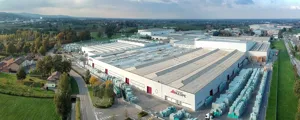The silent language of materials: shaping space, emotion, and connection in architecture
Synthetic Architecture
Material is more than a functional element in architecture—it is a language that shapes experience, perception, and connection. While materials are often discussed in terms of their physical properties, their expressive power extends far beyond structural concerns. The way a material interacts with its surroundings, its response to time, climate, and touch, all contribute to the architectural narrative. Materiality is not just about human needs; it is about the relationships it forms with the environment and, in turn, how those relationships shape human experience.
At Synthetic Architecture, our work is deeply rooted in understanding material beyond its physicality. Whether designing ecological structures, researching AI-assisted material simulations, or experimenting with world building of a conceptual narrative, we consistently explore how materials shape spatial perception and human interaction. Our sketches, physical models, AI-aided architectural visions and constructed physical spaces often emphasize the tactile and contextual role of materials, pushing beyond traditional representations to create new possibilities in design.
In contemporary architecture, material selection is not just a technical decision but an expressive act. Materials communicate—whether through their texture, color, or how they age over time. The warmth of wood, the raw honesty of exposed concrete, or the fluid reflectivity of glass each tell a story. These choices influence how a space is perceived and experienced, shaping the way inhabitants interact with their surroundings. On our Instagram account “Synthetic Architecture”, where we frequently share AI-assisted storyboards for design concepts, we consistently engage in this discourse. By pairing material research with conceptual storytelling, we explore how textures, finishes, and environmental responses contribute to the emotional depth of architecture.
Beyond aesthetics, materials establish cultural and climatic connections. Architecture is deeply rooted in place, and the selection of materials can reflect local traditions, sustainable practices, and environmental responsiveness. A structure that acknowledges its context through material choices not only blends into its surroundings but also contributes to a more meaningful dialogue with the natural world. The way a building responds to light, wind, and temperature is largely dictated by its materials—this relationship defines its presence in the landscape. In our Dubai La Mer 38 Residential Villa, for instance, materiality was at the core of the design strategy. The project carefully integrates natural and industrial materials, balancing thermal comfort, arid climate resilience, and a strong connection to its climate character. The villa’s material palette responds to Dubai’s climate, using textures and finishes that reflect both pleasing, durable and environmental efficiency, demonstrating how material choices can enhance both aesthetic and functional aspects of a space.
Materiality also extends to sensory engagement. The tactile quality of a surface, the way it absorbs or reflects sound, even the scent it carries, all play a role in shaping emotional and physical responses to a space. A rough stone wall invites touch, a smooth metal surface reflects movement, and a timber interior offers warmth both visually and physically. These sensory interactions deepen the architectural experience, making spaces not just functional but immersive. In many of our speculative AI-generated designs, we focus on translating material sensations into visual narratives, inviting viewers to imagine the full spectrum of engagement—beyond what the eye can see.
Ultimately, materiality is what gives a building its voice. In an era where digital tools accelerate architectural production, the thoughtful selection of materials remains one of the most profound ways to create authenticity and meaning in design. At Synthetic Architecture, we see material research as a crucial element of both digital and physical design processes. Whether through hands-on projects, experimental AI sketches, or architectural storytelling on social media, our aim is to continuously challenge how materiality is perceived, discussed, and ultimately, experienced. By understanding materials not just as construction elements but as communicators of culture, emotion, and place, architects can shape more engaging, enduring, and responsive environments.









